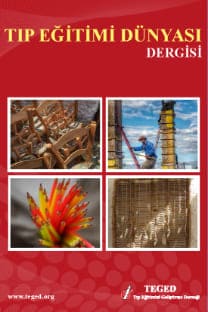DOKUZ EYLÜL ÜNVERSTESİ TIP FAKÜLTESİNDE TOPLUMSAL TANI ÇALIŞMASI: ÖĞRENCİ GERİ BİLDİRİMLERİNİN DEĞERLENDİRİLMESİ
Toplumsal tanı, evde izlem, bebek izlemi
Community Diagnosis Practicum at Dokuz Eylul University School of Medicine: Evaluation of Student Feedback
___
- Marshall G. Sosyoloji Sözlüğü. Bilim ve Sanat yayınları, 1999, Ankara, s:732
- Hançerlioğlu O. Toplumbilim Sözlüğü. Remzi Kitabevi, 3. bası, 2001, İstanbul
- University of Glasgow, Medical School. Community Diagnosis Course Documentation for the MBCHB degree. Session 2000-2001, Year 1, Term 2, Block 4, Section 4.1, pp:1-33
- Whitehead M. Eşitlik ve sağlık:kavram ve ilkeler. Türk Tabipleri Birliği yay. 1992, Ankara
- Musal B, Aksakoğlu G, Uçku R. Community-Based Education Programme of Dokuz Eylül School of Medicine. Education for Health, vol 16, No 2, July 2003:218-221
- Kılıç B, Uçku R, Günay T, Kaynak C, Konakçı SK, Keskinoğlu P, Sönmez Y, Giray H, Meseri R, Gürpınar E, Arslan LS. “Dokuz Eylül Üniversitesi Tıp Fakültesinde Topluma Dayalı Tıp Eğitimi İçin Örnek Bir Uygulama: Toplumsal Tanı Çalışması” I. Aktif Eğitim Kurultayı, 29-30 Mayıs 2004, İzmir, Kongre Kitabı s:53-59
- Davison H, Capewell S, Macnaughton J. et all. Community oriented medical education in Glasgow:developing a community diagnosis exercise. Medical Education, 1999,33:55-62
- Alıcı E, Gidener S.“Tıp eğitiminde değişim-yönetim ve örgütlenme”.Dokuz Eylül Üniversitesi Tıp Fakültesi Dergisi, Aktif Eğitim Özel Sayısı, 2001,sf:1-5
- Uçku R. “Topluma dayalı tıp eğitimi:Dokuz Eylül Üniversitesi Tıp Fakültesi deneyimi”, Toplum ve Hekim, 2001,c:16, s:3, sf:188-193
- Özkan H, Değirmenci B, Musal B ve ark. “Mezuniyet öncesi klinik tıp eğitiminde task’a dayalı öğrenim ve Dokuz Eylül Üniversitesi Tıp Fakültesi örneği” Dokuz Eylül Üniversitesi Tıp Fakültesi Dergisi, Aktif Eğitim Özel Sayısı, 2001, sf:11-23
- Günay T, Kulaç E, Gürpınar E. ve ark. “Toplum içinde tıp eğitimi uygulaması” Tıp Eğitimi Dünyası.2003, s:12, sf:12-17
- Magzoub ME. Studies on Community-Based Education. Maastricht 1994
- WHO. Community -Based Education of Health Personnel. Technical Report Series 746. 1987
- Aksakoğlu G. “Ekonomik sistemler ile tıp eğitimi etkileşimi”, Toplum ve Hekim, 2001, c:16, s:3, sf:171- 176
- Saçaklıoğlu F, Türk M. “Topluma yönelik-topluma dayalı tıp eğitimi neden ve nasıl”, Toplum ve Hekim, 2001, c:16, s:3, sf:181-187
- Sturmberg JP, Reid A, Khadra MH. “Community based medical education in a rural area:A new direction in undergraduate training” Aust. J. Rural Health 2001(9), Suppl. pp:S14-S18
- Doeden CL. “Community based education and rural development” Rural Funders Working Group Case Study No.2, Neighborhood Funders Group, Nebraska, USA, 2001
- Hyppola H, Kumpusalo E, Virjo I, et all.Evaluation of undergraduate medical education in Finnish community-oriented and traditional medical faculties: a 10-year follow-up. Medical education 2000;34:1016-1018
- Mennin SP, Kaufman A, Urbina C, McGrew M. Community-based medical education: toward the public health. Medical Education 2000;34:503-504
- ISSN: 1303-328X
- Yayın Aralığı: 3
- Başlangıç: 2000
- Yayıncı: Tıp Eğitimini Geliştirme Derneği
TEMEL HEKİMLİK UYGULAMALARININ ÖĞRETİLMESİ İÇİN BİR PROGRAM MODELİ: KLİNİK UYGULAMALARA GİRİŞ
Pemra C. ÜNALAN, Sibel KALAÇA, Serap ÇİFÇİLİ, Arzu UZUNER, Mehmet AKMAN, Özlem SARIKAYA, Mehmet Ali GÜLPINAR
Bülent KILIÇ, Canan KAYNAK, Pembe Keskinoğlu, Nuriye Ergül KARAKUŞ, Hatice GİRAY, Serap K. Konakçı, Yonca Sönmez, Reci Meseri, Guljan DÖNMEZ, Aysen YANIK, Dilek Dalkıran BİNBAY, Leyla S. ARSLAN, Erol GÜRPINAR, Türkan Günay, Reyhan Uçku
Meltem Çiçeklioğlu, Şafak Taner Gürsoy, Meral Türk Soyer, Zeliha A. Öcek, Feride SAÇAKLIOĞLU, Hilal Batı
EĞİTİM PROGRAMI GELİŞTİRME SÜRECİNDE ÖNEMLİ BİR AŞAMA: İHTİYAÇ BELİRLEME
Yeşim ŞENOL, Erol GÜRPINAR, Hakan ERENGİN, Hafize ÖZTÜRK, Tülin Tümtürk YILMAZ
